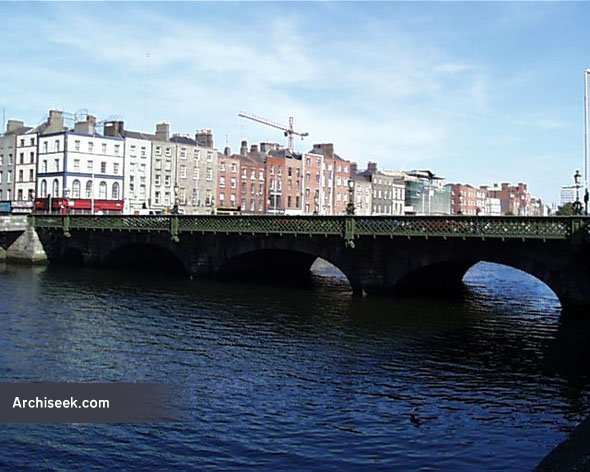1874 – Grattan Bridge, Dublin

Named after Henry Grattan MP (1746-1820) and opened in 1874. The original bridge on this site was built in 1676 and called Essex Bridge after the Lord Lieutenant Arthur Capel, Earl of Essex and was developed by Sir Humphrey Jervis. Fourteen years later severe flooding washed away a large part of the bridge so it was strengthened and repaired. Later in 1722 a statue of George I on horseback was placed on the bridge – this was removed during another rebuilding in 1753, designed by George Semple.
The current bridge, started in 1872, has been widened by extending cast iron supports out from the stonework so as to carry wide pavements on either side of the roadway. The bridge is lit by ornate lamp standards also in cast iron.
A description in The Irish Builder as it neared completion: “We have been for some weeks past observing the rapidity with which the works at the new Essex Bridge have progressed. The arches are complete, and the roadway is being laid. In the centre of the arches a space has been left, through which the gas and water mains are laid across upon iron bars. By this plan the future ripping up of the roadway will be avoided. The carriage way on the south side has been lowered about twelve inches, to suit the level of the new bridge. The culverts constructed on each side as a portion of the City Main Drainage Scheme, at a cost of about .£6,000, are for the present to remain unutilised. The footway, 12 ft. in width, is supported on iron cantelivers springing from the stonework of arches. The balustrade is of iron trellis-work. The opening will probably take place soon after the date of our next issue. As previously remarked, the old foundations of Semple’s bridge have been utilised. The plans are by Mr. B. B. Stoney, Engineer to the Port and Docks Board. Mr. William J. Doherty is the contractor, to whom the greatest credit is due for the manner in which his contract has been carried out.”





